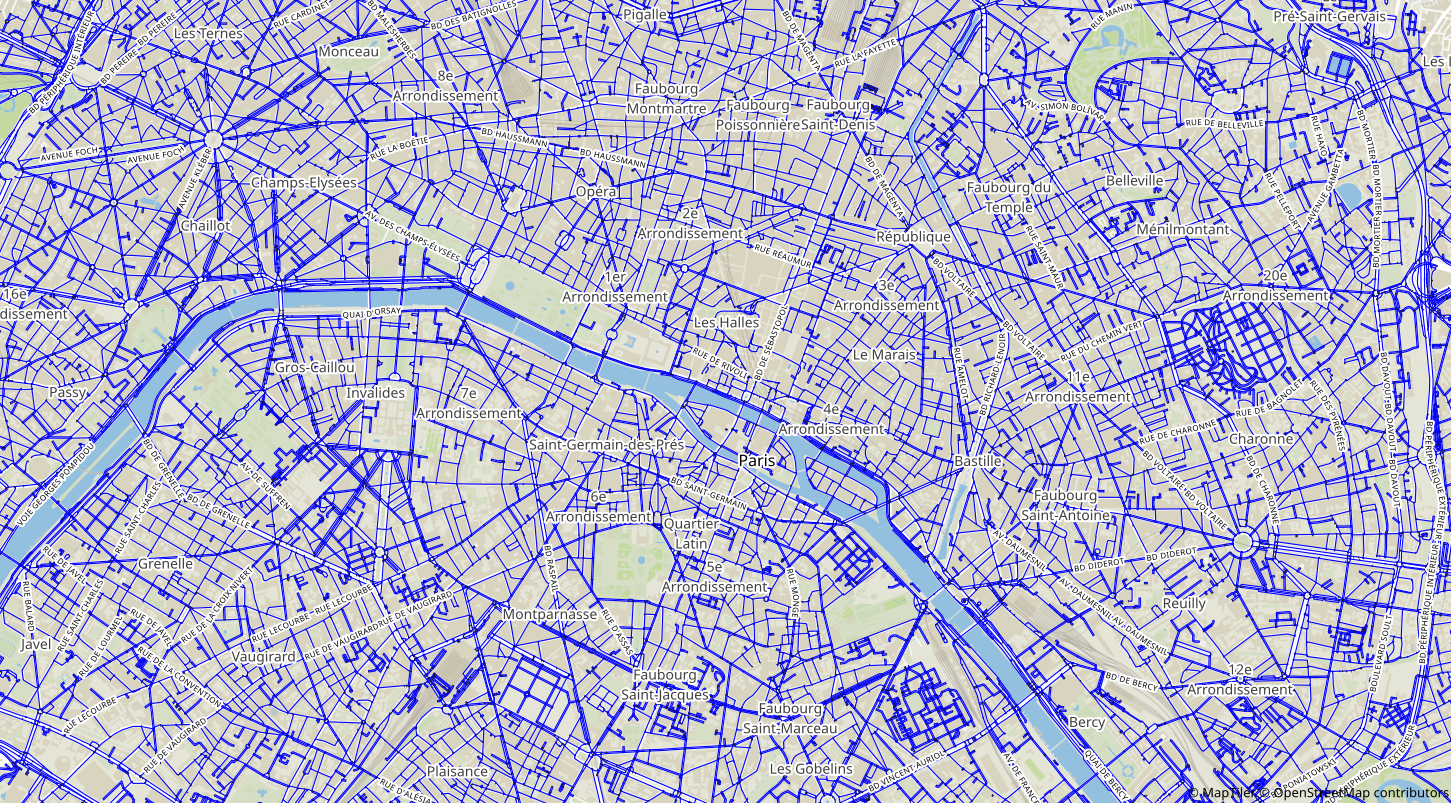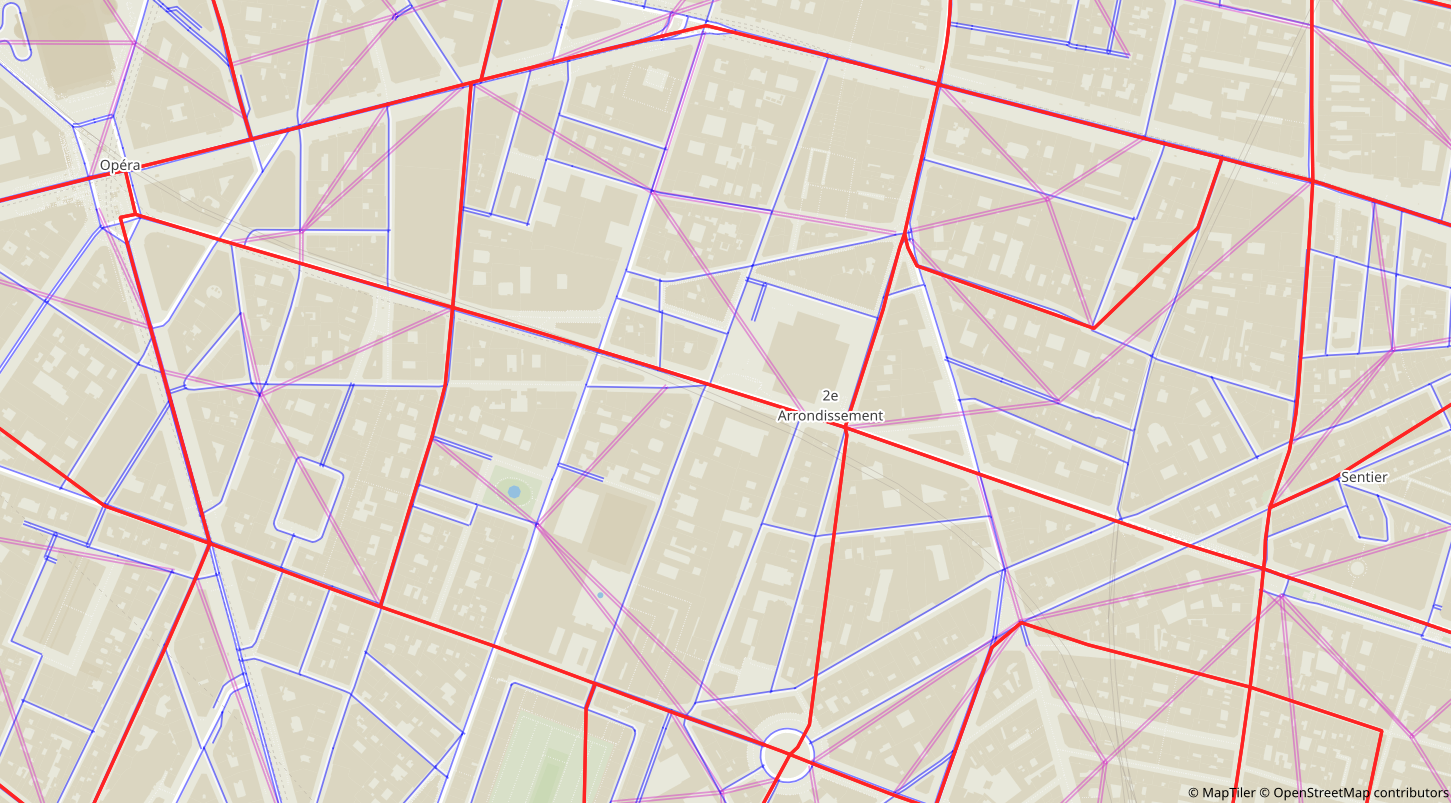Metropolis
Running Metropolis
Basic Principle
Running the Metropolis simulator can be summarized by these three steps:- Write the input JSON files
- Run the simulator in a terminal
- Read and analyze the output JSON files
Input Files
Metropolis requires 3 input JSON files:- Road-network: list of edges with their characteristics, list of vehicle types with their characteristics
- Agent file: list of the agents with their characteristics (including modes available)
- Simulation parameters
Units
- Time: number of seconds since midnight (10AM is 36 000)
- Travel time: number of seconds
- Length: meters
- Speed: meters per second (50 km/h is 50 ÷ 3.6 m/s)
- Value of time: utility unit (e.g., €, $ or an abstract unit) per second
- Flow: vehicle length (in meters) per second
Road Network JSON File
Example Road Network JSON File
{
"graph": {
"edges": [
[
0,
1,
{
"base_speed": 10.0,
"length": 10.0,
"constant_travel_time": 1.0,
"bottleneck_flow": 1.0,
"lanes": 2,
"speed_density": {
"type": "FreeFlow"
},
"overtaking": true
}
],
[
1,
2,
{
"base_speed": 20.0,
"length": 10.0,
"speed_density": {
"type": "ThreeRegimes",
"value": {
"beta": 1.1,
"jam_density": 0.2,
"jam_speed": 2.0,
"min_density": 0.8
}
}
}
]
]
},
"vehicles": [
{
"headway": 10.0,
"pce": 1.0
},
{
"headway": 30.0,
"pce": 5.0,
"speed_function": {
"type": "Piecewise",
"value": [
[
0.0,
0.0
],
[
25.0,
25.0
],
[
100.0,
25.0
]
]
},
"restricted_edges": [
1
]
}
]
}
Agent JSON File
Example Agent JSON File
[
{
"id": 1,
"mode_choice": {
"type": "Logit",
"value": {
"u": 0.5,
"mu": 1.0
}
},
"modes": [
{
"type": "Trip",
"value": {
"legs": [
{
"class": {
"type": "Road",
"value": {
"origin": 0,
"destination": 1,
"vehicle": 0
}
},
"stopping_time": 600.0,
"travel_utility": {
"type": "Polynomial",
"value": {
"a": 1.0,
"b": -0.003
}
},
"schedule_utility": {
"type": "None"
}
},
{
"class": {
"type": "Virtual",
"value": 300.0
},
"travel_utility": {
"type": "Polynomial",
"value": {
"b": -0.003
}
}
}
],
"departure_time_model": {
"type": "ContinuousChoice",
"value": {
"period": [
0.0,
200.0
],
"choice_model": {
"type": "Logit",
"value": {
"u": 0.5,
"mu": 1.0
}
}
}
},
"origin_schedule_utility": {
"type": "None"
},
"destination_schedule_utility": {
"type": "AlphaBetaGamma",
"value": {
"t_star_low": 30.0,
"t_star_high": 30.0,
"beta": 1.0,
"gamma": 4.0
}
},
"pre_compute_route": true
}
},
{
"type": "Trip",
"value": {
"legs": [
{
"class": {
"type": "Virtual",
"value": 900.0
}
}
],
"departure_time_model": {
"type": "Constant",
"value": 50.0
}
}
}
]
}
]
Parameters JSON File
Example Parameters JSON File
{
"period": [
0.0,
200.0
],
"network": {
"road_network": {
"recording_interval": 50.0,
"approximation_bound": 1.0,
"spillback": true,
"max_pending_duration": 20.0,
"algorithm_type": "Best"
}
},
"learning_model": {
"type": "Exponential",
"value": {
"alpha": 0.99
}
},
"init_iteration_counter": 1,
"stopping_criteria": [
{
"type": "MaxIteration",
"value": 2
},
{
"type": "DepartureTime",
"value": [
0.01,
100.0
]
}
],
"update_ratio": 1.0,
"random_seed": 19960813,
"nb_threads": 24
}
Running the Simulator
Output Files
Metropolis output 7 different file types:-
log.txt: text file with the log of the simulation -
report.html: HTML file with a summary table and graphs -
iteration{n}.json: JSON file with aggregate results, for each iteration -
running_time.json: JSON file with running times for the different parts of the simulator -
agent_results.json.zst: compressed JSON file with agent-specific results -
skim_results.json.zst: compressed JSON file with network skim results (i.e., OD pair travel times) -
weight_results.json.zst: compressed JSON file with network weight results (i.e., edges' travel times)
report.html
iteration{n}.json
agent_results.json
skim_results.json
weight_results.json
Application Example
Running a full-scale application of Metropolis can be done in 5 steps (there is a Python script for each step):- Pre-processing the road network (e.g., from OpenStreetMap data)
- Connecting the origin/destination zones to the road network through connectors
- Generating the population
- Filtering the trips from the population that should be simulated
- Writing the Metropolis input files
Pre-Processing the Road Network
- Compatible data sources: OpenStreetMap and HERE
- Country-level and region-level OpenStreetMap data can be downloaded from https://download.geofabrik.de
- Filters can be used to discard less relevant roads (e.g., roads tagged as "residential" in OpenStreetMap)

Creating Connectors
- Trips' departure/arrival points are aggregated at an origin/destination zone level
- In France, IRIS zones are a good compromise between accuracy and running time
- Virtual nodes are created to represent the departure/arrival points of the trips in a zone
- Connectors (virtual edges) are created to connect the virtual nodes to the road network

Generating and Filtering the Population
- A synthetic population can be created from Hörl and Balac (2021)'s methodology
- Python scripts to convert the output from Hörl and Balac (2021) to data compatible with Metropolis
- Filters: simulated period, modes
- Intra-zonal trips are removed
Hörl, S. and Balac, M., 2021. Synthetic population and travel demand for Paris and Île-de-France based on open and publicly available data. Transportation Research Part C: Emerging Technologies, 130, p.103291.
Writing Metropolis Input Files
- Python script to write the 3 Metropolis input JSON files from the output of the previous steps
-
Many parameters to choose and calibrate:
- Vehicle length and PCE
- Simulated period
- Individual preferences (alpha, beta, gamma, etc.)
- Edges' capacities
- Edges' constant travel times